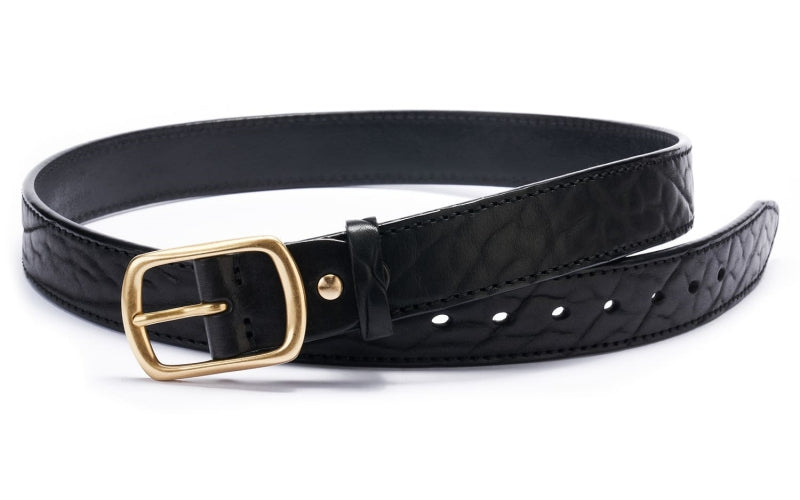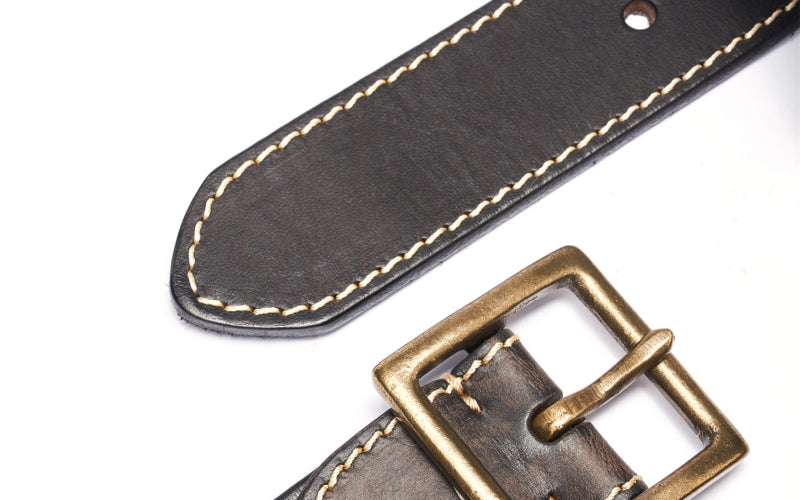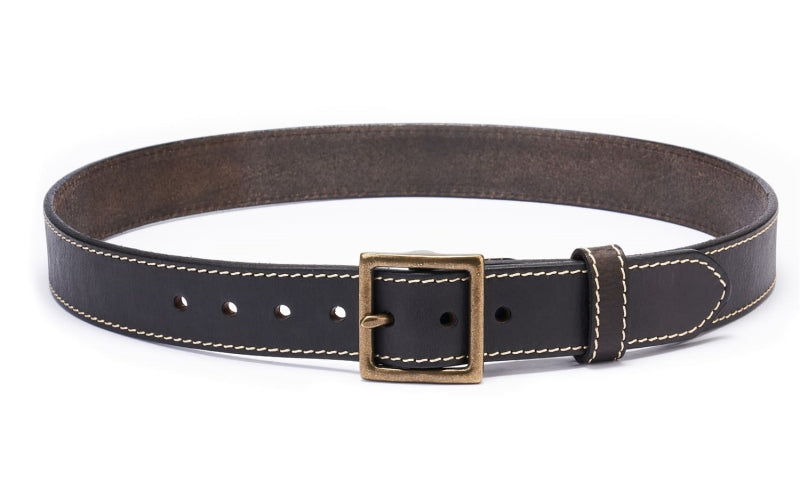
What is the Most Durable Leather Belt? (Maybe It’s Not the One You’re Wearing)
Let’s face it: Most belts are like that flaky friend who bails on plans last-minute. They crack, fade, or snap just when you need them most—like during a job interview or while chasing your escaped dog down the street.
But what if I told you there’s a leather belt out there that can survive apocalypses, toddlers, and even your questionable decision to “break it in” by wearing it straight into a hot tub?
Welcome to the ultimate guide to finding the most durable leather belt—a.k.a. the Chuck Norris of accessories. We’re talking 1200+ words of pure, unadulterated leather lore. Buckle up, buttercup.
1. The Great Leather Showdown: Why Full-Grain is the Undisputed Champ
First rule of Durable Belt Club: Not all leather is created equal. Let’s break down the contenders:
A. Full-Grain Leather: The Beyoncé of Belts
-
What it is: The top layer of the hide, complete with natural scars and grain. No sanding, no makeup.
-
Why it’s durable: Tight fiber structure + natural oils = resists moisture, scratches, and your coworker’s “funny” habit of flicking pens at your waist.
-
Aging like fine wine: Develops a patina—fancy talk for “gets sexier with age.”
B. Top-Grain Leather: The Almost-Famous Sibling
-
What it is: Sanded and buffed to hide imperfections. Softer, but weaker.
-
Durability verdict: Good for date night, bad for farm chores.
C. Genuine Leather: The Misleading Label
-
What it is: A marketing term for “scraps glued together.”
-
Durability verdict: Falls apart faster than a TikTok relationship.
D. Bonded Leather: The Imposter
-
What it is: 10% leather dust + 90% wishful thinking.
-
Durability verdict: Might survive a Netflix binge, not a camping trip.
Pro Tip: If the label says “genuine,” run. Fast.
2. The Science of Sturdiness: 5 Factors That Make or Break Your Belt
A. Tanning Techniques: Vegetable vs. Chrome
-
Vegetable-Tanned: Uses tree bark (yes, really). Eco-friendly, stiff at first but molds to your body. Think: Breaking in a baseball glove.
-
Chrome-Tanned: Chemical bath for softness. Faster, cheaper, but less breathable.
B. Thickness: Go Big or Go Home
-
Ideal range: 3.5–4.5 mm. Thinner than a Tinder date’s excuses? It’ll snap. Thicker than a ’90s boy band member’s hair? Uncomfortable.
C. Stitching vs. Glue: The Seam Wars
-
Hand-Stitched: Uses waxed thread, doubled over. Survives pull-ups, tug-of-war, and your nephew’s fascination with yanking it.
-
Glued Edges: Peels faster than a sunburned tourist.
D. The Buckle: Weakest Link Alert
-
Materials: Solid brass > zinc alloy > plastic (shudder).
-
Attachment: Chicago screws (removable) beat prongs (bendable).
E. Edge Painting: The Silent Hero
-
What it is: Coating on the belt’s edges to prevent fraying.
-
Pro move: Look for rolled edges—smoother than a jazz saxophonist.
3. Mythbusting: “But My Uncle’s Friend Said…”
Myth 1: “All leather belts are basically the same.”
Reality: Comparing full-grain to bonded leather is like comparing a Tesla to a tricycle.
Myth 2: “Thicker always means stronger.”
Reality: A 5mm belt made of cardboard-like leather will snap. Quality > bulk.
Myth 3: “Exotic leathers (alligator, ostrich) are tougher.”
Reality: They’re durable but require babying. Full-grain cowhide is the workhorse.
4. The Beltley Difference: How We Engineer Belts That Outlive Trends
At Beltley.com, we treat belts like heirlooms. Here’s our secret sauce:
-
Sourcing: Full-grain hides from Italian farms where cows are fed organic grass and probably listen to Vivaldi.
-
Tanning: 30-day vegetable tanning process. Slow and steady wins the race.
-
Craftsmanship: Hand-stitched by fourth-generation artisans who laugh at the word “fast fashion.”
-
Testing: Every belt undergoes a “Real Life Simulator”—yanking, sweating, and even a coffee spill test.
True story: One of our belts survived being run over by a Tesla. The Tesla needed repairs.
5. Care Tips: How to Keep Your Belt Alive Longer Than Your Houseplants
Do:
-
Condition quarterly with Bickmore Leather Cream (it’s like a spa day for your belt).
-
Store flat—no hooks, no crumpling, no “tossing it into the abyss of your closet.”
-
Rotate belts like you rotate tires. Daily wear = faster aging.
Don’t:
-
Soak it (leather isn’t a sponge).
-
Expose to heat (dryers, radiators, or your “brilliant” idea to speed-dry it with a hairdryer).
-
Ignore scratches—buff gently with a horsehair brush.
Confession: I once conditioned a belt with olive oil. It smelled like a salad and attracted ants. Don’t be me.
6. FAQ: Your Burning Questions, Answered
Q: Can a leather belt last a lifetime?
A: Yes—if it’s full-grain, cared for, and you don’t accidentally donate it during a KonMari phase.
Q: How tight should a durable belt be?
A: Snug enough to hold up pants, loose enough to slide two fingers in. No muffin-top mandates here.
Q: Why does my belt squeak?
A: Leather’s natural fibers rubbing. Rub a dab of beeswax on the inside—it’s like couples therapy for materials.
Q: Can I wear the same belt daily?
A: Sure, if you want it to retire early. Rotate between 2-3 belts for longevity.
7. The Investment Angle: Why Cheap Belts Cost More in the Long Run
Let’s math:
-
$20 belt: Replaced yearly × 10 years = $200
-
$150 Beltley belt: Lasts 15+ years = $150 (and infinite compliments)
Plus, our belts come with a 10-year warranty—because we’re cocky like that.
8. The Ultimate Checklist: How to Spot a Durable Belt
Next time you’re shopping, ask:
-
Is it full-grain leather? (Demand proof.)
-
Are the edges rolled or painted?
-
Is the buckle solid metal with Chicago screws?
-
Does it have reinforced stitching? (At least 6 stitches per inch.)
-
Does the seller offer a warranty longer than a goldfish’s memory?
9. Why Beltley Belts Are the Last Belt You’ll Ever Buy
-
Custom sizing: Because “one-size-fits-all” is a lie invented by sock companies.
-
Ethical sourcing: Our cows are happier than a Kardashian in a selfie museum.
-
Style meets substance: From boardroom to brewery, without looking like you’re trying too hard.
Final Thought:
A durable leather belt isn’t an accessory—it’s a silent promise to future-you. No more emergency mall runs, no more “Oops, my pants fell down” moments. Just reliable, rugged style that ages with you (gracefully, unlike your college haircuts).
Ready to upgrade? Explore Beltley’s collection —where belts are built to outlive trends, toddlers, and questionable life choices.








